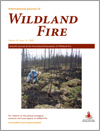International Journal of Wildland Fire
Volume 29
Number 10 2020
In 2009, new federal guidance in the United States expanded options available to wildland fire managers. We explored this guidance in a context informed by concurrent weather and resource conditions, finding it helped expand the use of strategic responses beyond suppression. We also found a manager’s desire and ability to suppress is either complemented by fire weather, at odds with fire weather, or put aside due to other priorities. We highlight opportunities to improve fuel heterogeneity in fire-adapted forests.
National Burned Area Composite (NBAC) combines an automated system for mapping burned areas from satellite imagery with similar maps from Canadian fire management agencies for estimating carbon emissions of Canada’s forests. This paper describes the NBAC system and presents burned area of Canada’s forests from 2004 to 2016, including estimates of uncertainty.
Surface organic layer severity, a gauge of carbon loss from fire, was reliably modelled with a multiple linear regression approach using Landsat 8 data for predicting fire’s effect on organic soil. The 2014 fires in the Plain ecoregion were more severe than the 2015 fires and all fires in the Shield ecoregion.
This study aimed to evaluate the accuracy of MODIS burned-area products and active-fire pixels in the different Brazilian biomes, as well as to describe the fire regime in the country with the MCD64 product and a set of environmental variables.
The objective of this work was to understand fire frequency, wild and prescribed, on the Talladega National Forest over the past 20 years. The analysis was conducted using a new geospatial tool that utilised a monthly time scale and allowed separation of data into dormant (winter) and growing (spring/summer) season fires.
Summary statistics of variations of daily Forest Fire Danger Index (FFDI) were compared with fire occurrence data in six forested areas in southern Australia. Maximum hourly FFDI performed the best overall, although there were no statistically significant differences between variants detected, including between those calculated using different drought indices.
Plant species richness, and the number of plant species of significance to Australian desert Aboriginal people, declined with time since fire. A fine-scale mosaic of post-fire seral stages created by regular anthropogenic patch burning enables more efficient harvesting of a greater variety of plant-based resources.
Amazonian cangas are azonal savannas without regular fire events. We show that diversity metrics are not negatively affected by a single fire event. Furthermore, only small shifts in species composition were observed. Thus, our data indicate the maintenance of important ecosystem properties despite an occasional wildfire in the canga community.
We investigated seed germination of 12 Anigozanthos flavidus populations in response to fire-related cues and after-ripening durations. We found that dormancy degrees were highly variable among populations. Glyceronitrile and heat significantly improved germination in 12 populations, but was less effective when combined. After-ripening for 4 months or more led to loss of viability, especially for deep-degree dormant populations.





